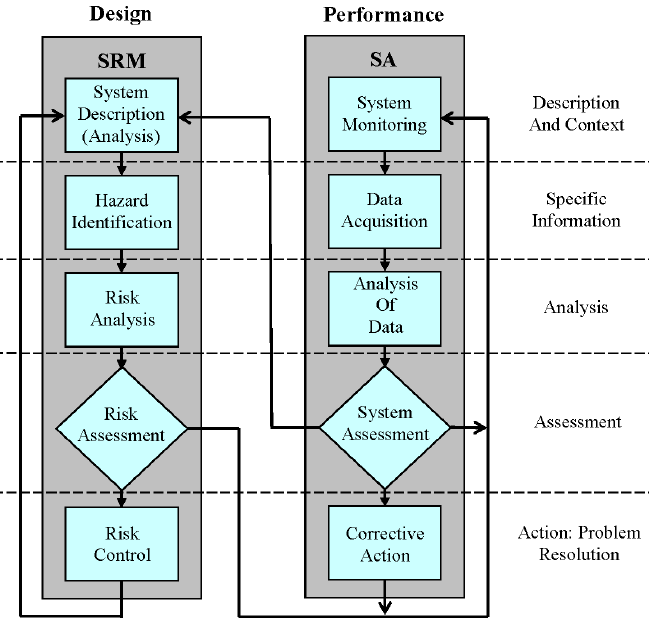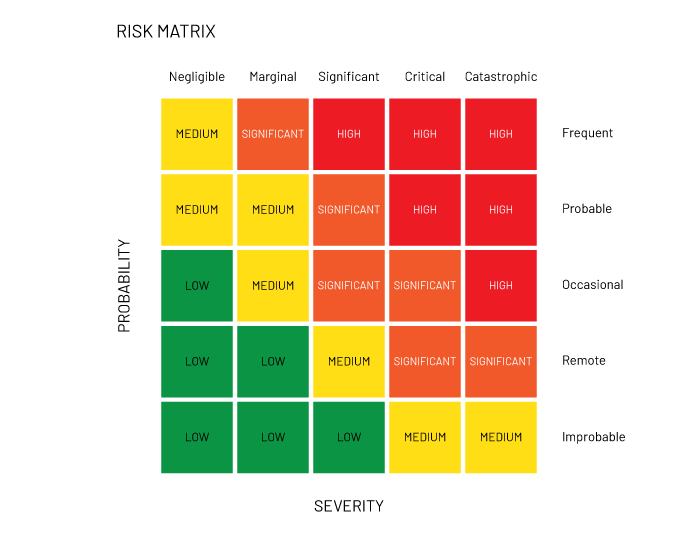How Well Do You Understand Risk Management in Your SMS?

Aviation safety managers are tasked with managing all aspects of fully implemented aviation safety management systems (SMS). Naturally, most laypersons imagine safety managers reacting to accidents, incidents, and irregularities (issues or events) as their primary job function.
It is also probable that most managers outside the safety department believe safety managers have nothing better to do than sit around waiting for "safety issues" to surface.
Related Aviation Safety Manager Articles
- What Makes a Good Aviation Safety Manager?
- How to Manage Aviation SMS Budget Expectations - for Safety Managers
- How Safety Managers Increase Their Power in Aviation SMS
Risk management is more than simply waiting for
- employees to report safety issues; or
- auditors to submit audit findings.
In reality, reported safety issues and audit findings are safety assurance activities. These two activities are the main SMS data collection engines for both new and mature SMS implementations. As these system monitoring activities detect "anomalies," safety managers process these items through documented, formal risk management processes.
Safety managers are concerned with reducing risk to the organization as they manage these safety assurance activities. This article discusses hazards and risks and the common methodology to evaluate risk in modern aviation SMS. We also discuss reducing your exposure to risk and how to bring exposure to the forefront of your risk management strategies.
But first, please review the interaction between safety risk management (SRM) and safety assurance (SA) processes. New SMS implementations will spend most of their risk management efforts on the SA side. By years two and three of the SMS implementation, the company will be comfortable with SMS processes and begin to incrementally document SRM data elements, namely:
- Hazards;
- Associated Risks; and
- Risk Controls.

Common Confusion of Hazard and Risk in Aviation Risk Management
Many safety managers today still are confused regarding the difference between hazards and risks. They often flip the two definitions. Aviation-related hazards are as abundant as their associated risks. For aviation safety professionals to exchange ideas and discuss risk management methodologies, they must speak a common language.
If you are talking to me about hazards and risks and I have another mental picture of hazards and risks, we could be talking in circles and left scratching our heads. We could needlessly spend five minutes talking until my mind grasps your definition of hazards and risks. Therefore, if we are to discuss exposure, our terms must be in alignment.
Let's cut to the chase and quickly define hazard and risk. I also was confused when I started creating our first version of the "Proactive Hazard Analysis Tool" (PHAT) in 2009. Now I use mental pictures to distinguish the two, which I'll explain shortly.
Related Aviation Risk Management Articles
- Difference Between Hazards, Risks & Control Measures in Aviation SMS
- The Difference Between Hazard and Risk
- Difference Between Hazards and Risks in Your Aviation SMS
Definition of Hazard in Aviation Risk Management

A hazard is anything that has the ability to cause harm or negatively affect operations.
Wow! That could be just about anything. For example:
- Mountains - I could run into them
- Untrained personnel
- Unauthorized personnel
- Unstable geo-political regions
- Rain, snow, heat
- Birds
- Bears, moose
Imagine how large this list could reach. Your airline or airport could literally have hundreds of hazards. How do you manage all of these hazards? If you are like many safety managers, you will use an MS Excel spreadsheet, which is marginally better than paper. The best solution for categorizing and managing hazards is a modern SMS database.
Remembering Definition of Risk in Aviation Risk Management
Now let's consider risk. Here is where a little word or mind game comes in handy.
When I think of risk, my mind jumps to:
- "Risk associated with the hazard" or
- "Consequence that would occur should the hazard manifest itself."
The first mental trick is my typical way of keeping the two straight. The mountain is a hazard. Running into the mountains and destroying my aircraft is the risk. Death by mountain collisions is also a risk.
The "Untrained personnel" is the hazard. Any of the stupid things an untrained employee could do is the risk associated with this untrained employee (the hazard). How about the risk of refueling an aircraft with the wrong grade of fuel?
Related Aviation Risk Management Articles
- How to Optimize Risk Management Processes for Aviation SMS
- What Is Modern Aviation Risk Management Cycle - With SMS Resources
- Why Safety Risk Management Pillar Rocks in Aviation SMS - Best Practices
Common Risk Assessment Dimensions in Aviation SMS

When considering risk, there are two dimensions commonly used to evaluate the impact on operations:
- Probability; and
- Severity.
Probability and severity are highly intuitive, especially if you are a gambler. You may have seen the term "likelihood" used in place of probability. They are of course interchangeable. When you combine probability and severity, you will calculate a "risk index" that determines the priority of this particular safety issue. You may see a risk index such as 1A, 1B, 5A, 5B, etc.
Probability is easy to define:
- How likely will the hazard manifest itself? (probability) or
- How many times has this hazard manifested itself within the past xx years?
- How likely will we have an employee injury this year?
- How likely will we have a weight and balance issue if we use a checklist?
Severity is also fairly easy to calculate once you put some thresholds in place.
- What is the dollar amount of the damages? or
- What type of injuries occurred?
- Was it simply a bump on the head or broken bones?
- How badly will this event affect our reputation?
When evaluating probability and severity, safety managers must focus not on just equipment and personnel. These are the common elements that are routinely considered in a typical risk assessment:
- People (employees, customers, contractors);
- Equipment (aircraft, vehicles or buildings);
- Environment (oil spill, fires); and
- Reputation.
Taking Your Risk Assessments to the Next Level

The risk analysis process may delve deeper than probability and severity. Another dimension used by approximately 5% of safety managers is exposure. Exposure is simple to understand. If your operation is not exposed to a hazard, there is no chance of risk. The risk is transferred away from your operation.
Exposure doesn't have to be an all-or-nothing risk management approach. Reduce your exposure to a hazard and risk may be proportionately reduced.
We won't discuss exposure in-depth, but some companies use all three dimensions when evaluating risk:
- Probability;
- Severity; and
- Exposure.
Let's contrast using the "exposure" dimension with the most common practice of using simple probability and severity. There are pros and cons to both approaches. The conventional probability and severity tactic excels in simplicity.
- Simple to understand;
- Simple to explain to other managers;
- Simple to teach to new safety managers;
- Simpler to justify to SMS auditors.
Since risk assessments are most often highly subjective, I prefer the simple "probability and severity" approach. Exposure should be considered when treating the issue of preventive/corrective actions. However, treatment remains within the control of the department heads. Can you rely on them to consider exposure each time they deal with safety issues in your risk management processes?
The main benefit of using exposure in performing risk assessments is that the safety team will naturally seek ways of reducing exposure to hazards. Exposure will never be overlooked when analyzing strategies to reduce risk to as low as reasonably practical (ALARP). Taking this one step further, if department heads are also trained in using exposure when drafting corrective/preventive actions, they may be inclined to address issues differently.
Using Exposure in your risk management processes takes your SMS from reactive thinking to a more proactive and hazard avoidance risk management strategy.
Related Aviation Risk Management Articles
- Difference Between Reactive, Predictive and Proactive Risk Management in Aviation SMS
- What Is Reactive Risk Management (Why It’s Essential for Aviation SMS)
- How to Practice Reactive, Proactive, and Predictive Risk Management in Aviation SMS
Final Thoughts on Using Exposure in Risk Management

New safety managers have considerable work to do:
- Developing safety policies and procedures;
- Training employees;
- Keeping on top of department heads to manage their issues;
- Developing safety promotion activities; and
- Communicating progress to upper management.
Safety managers are busy! Many don't have time for thinking outside the box and doing more than what is required.
Probability and severity concepts are taught at most aviation SMS training courses. It is simple to understand and there is considerable documentation on performing risk assessments using these two dimensions. This is perhaps why most safety managers stick to the basics.
More mature and forward-thinking safety managers should consider using exposure as another way of evaluating hazards. This may be performed either formally or informally. We, of course, prefer that risk assessments are structured and well documented, just as all of your other risk management procedures are well documented in your SMS manual.
Personally, I like using the "exposure" dimension because it forces me to think. But if you asked me about using exposure five years ago, I would have resisted the idea. I liked to keep things simple. Are you ready to consider using exposure in your risk assessments?
Being able to add exposure as your third dimension is simply one of the great SMS Pro features. SMS Pro has very mature risk management processes developed by safety managers across the world.
Since 2007, we have been providing the best aviation SMS database software on the market. Each day, I become more confident that SMS Pro is the best database software because our clients have been repeating this same story for years. I'm beginning to believe them. Do you want to see why? Watch these short demo videos to learn how much time you could save by using low-cost, commercially available SMS database software.
Live SMS Pro Demo
Do you have any questions? Want to see the system live? Sign up for a live demo.
Last updated October 2025.







